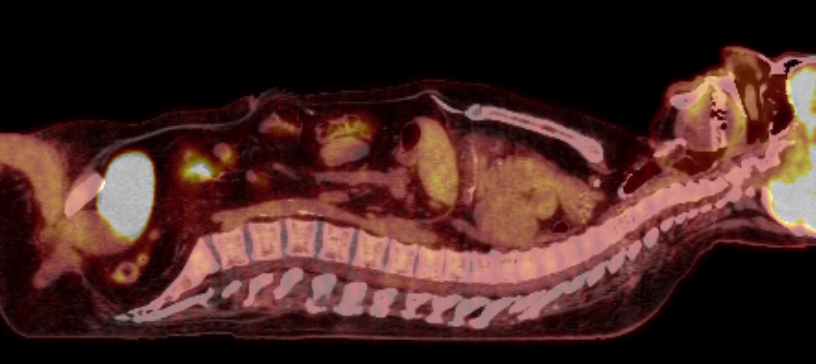
This colorful portrait of me, insides and all, is one of a series of CAT/PET scans recently produced to determine whether or not a lump in my right lung is malignant. I particularly like how it captured the profile of my nose. Thankfully, the lump appears to be some scar tissue that formed during a serious bout of bronchitis a few years back, not cancer.
The image, however, also serves to illustrate what’s so easily ignored, namely the remarkable assemblage of internal organs that sustain and enable life. Our bodies are comprised of roughly 40-trillion human cells which have differentiated themselves and their functions among our various organs, each responsible for specific processes that sustain us. Following a morphological scheme embodied within our genetic code, each organ operates according to its own specialized purpose within a cooperative model of organization.
Biologically, cooperation is more powerful than competition. Each of our 40-trillion cells, self-replicating, discreet operating entities themselves, cooperate within the interdependent living system of the body – communicating, exchanging materials, growing, reproducing, and dying in a continuously fluid dance of dynamic kinetic stability. In this way, we go on for a while, ever-changing yet miraculously remaining who we are until the flow of life-energy runs out. As songwriter Leonard Cohen observes, “You win a while, and then it’s done, your little winning streak.”
Have you thanked your kidneys lately? You might think about it. I recall how my late father, who had uncomfortable pain in his right leg due to poor circulation, would refer to his “damn leg” while we were on a walk. I’d remind him that, after all its years of service on his behalf, his leg deserved better than cursing it. “OK, fine,” he’d say, “my darling leg,” but he didn’t mean it.
Like many of us with old bodies I have physical problems and occasional pain here and there, but I don’t cast blame. Getting angry at my aging body is the last thing I need. Sure, it’s frustrating to experience declining health, my tired organs wearing out, but I try not to forget how long and hard they’ve worked in carrying out their tasks, and I regularly take time thank them, literally.
One exercise technique in thankfulness I use is visualization. For example, I imagine cradling my right kidney in one hand while stroking it gently with my other hand, feeling its silky softness under my fingers. While I mentally caress it in this way, I offer comfort and thankful, loving thoughts on its behalf, appreciation for its 75 years of selfless effort. On subsequent days I do the same for my liver and my heart, my lungs and my legs. In this way, like a CAT scan, I move through my inner self. A little appreciation, I figure, can’t hurt, and might even help.
Wisdom about how we treat ourselves is offered early in life, if we’re open to hearing it. “Row, row, row your boat,” we’re told as children, “gently down the stream.” Not aggressively, mind you, not competitively, but gently. And not against the current, but down the stream, going with the flow, harmoniously. Moreover, we’re instructed on how to relate emotionally to navigating our “boat,” our vehicle in this life, our body – “Merrily, merrily, merrily, merrily,” we’re told, not angrily, angrily, angrily, angrily. It all makes perfect sense to me.
It makes perfect sense to me too. Thank you.
This put a smile on my face!
Bob and I call our bodies our “space ships” 🚀